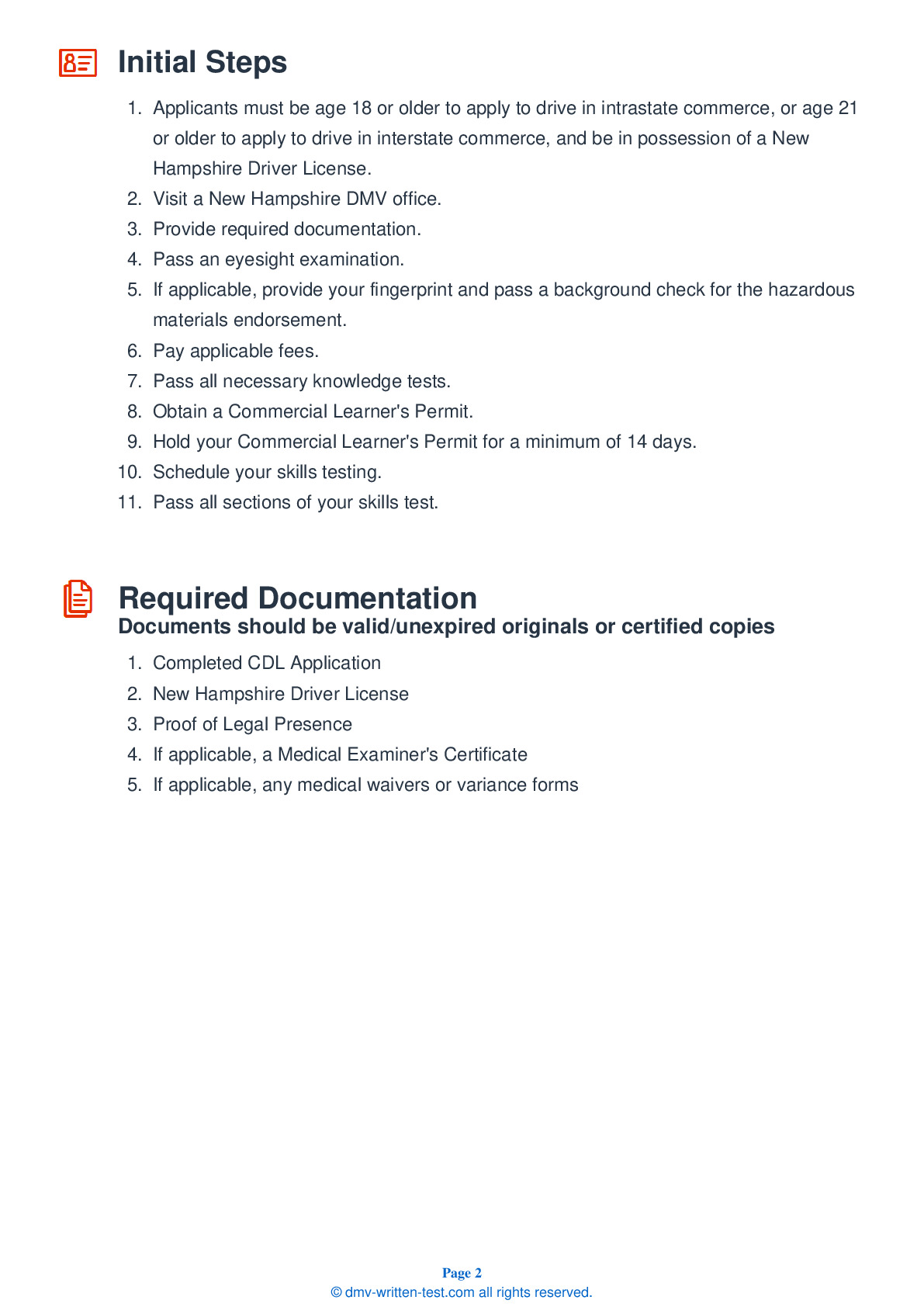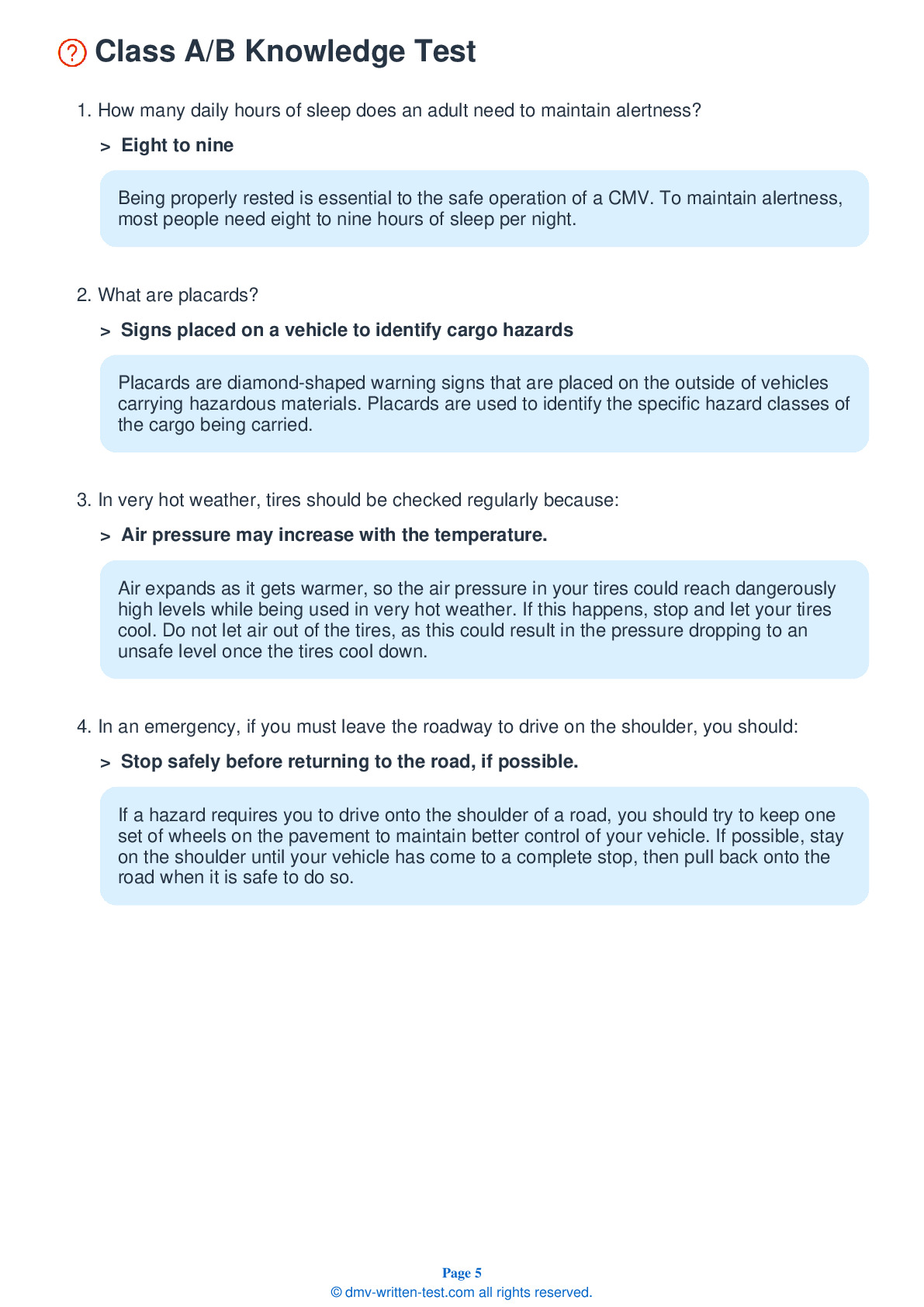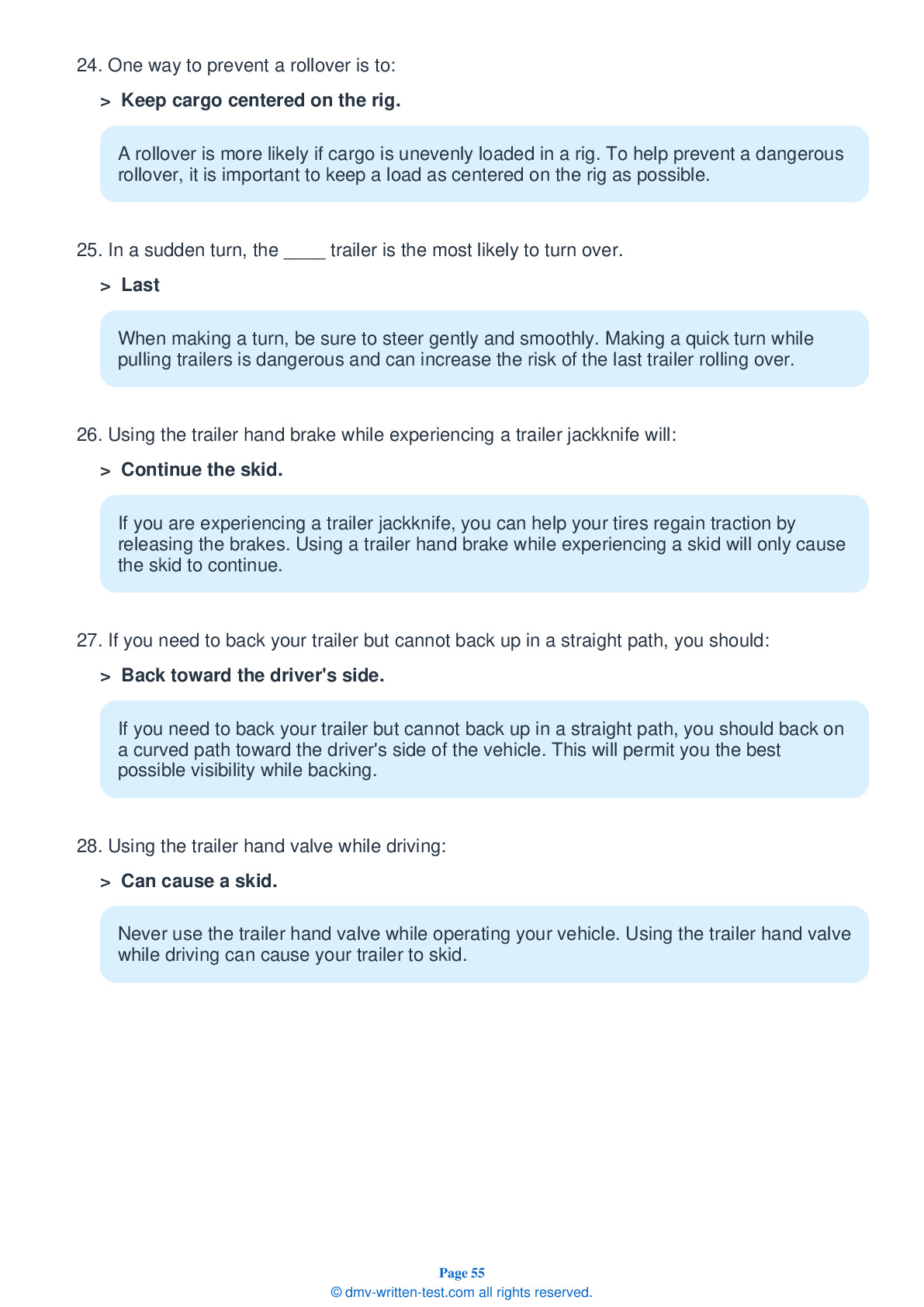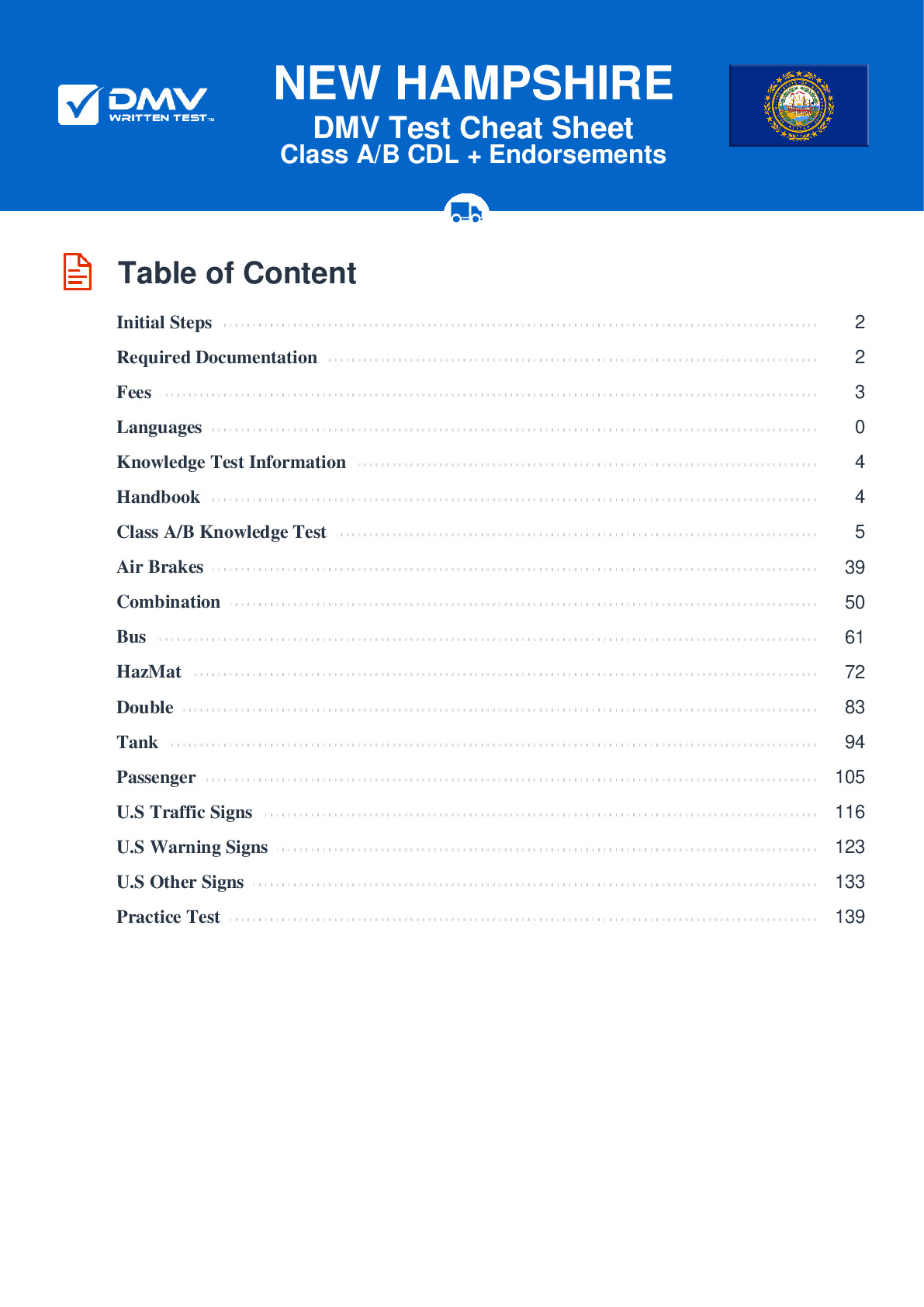Knowledge Test Class B
This license is required for driving a single vehicle with a GVWR of more than 26,001 pounds, and a trailer not to exceed 10,000 pounds gross vehicle weight rating, or a vehicle designed to transport 24 or more people (including the driver). To receive this license, applicants must pass a 50-question test. To pass, applicants must answer 40 questions correctly. Each question has four possible answer choices. Test questions come from the New Hampshire CDL Driver’s Guide. Questions come from chapters covering: Introduction, Driving Safely, Transporting Cargo Safely, Air Brakes (if applicable), Pre-Trip Vehicle Inspection Test, Basic Vehicle Control Skills Test and On-Road Driving.. Endorsements that may be used with a Class B CDL are: Hazardous materials, Tank, Passenger, HazMat and Tank, Air Brakes and School bus.
1. Which of the following is not a type of tie-down equipment?
You must use the proper number of tie-downs when securing cargo on a flatbed trailer. Examples of tie-down equipment includes ropes, straps, and chains.
2. When checking your tires as part of the pre-trip inspection, you should look at the:
When checking your tires as part of a pre-trip inspection, it is important to verify that the tire pressure is neither too low nor too high.
3. When changing lanes, turn signals:
Always signal your intentions before turning or changing lanes. Do not assume that other drivers will move out of your way simply because you are signaling to turn.
4. On a curve, the posted speed limit:
The posted speed limit on a curve may be safe to be taken by cars, but can still be too fast to be taken by larger vehicles, such as trucks. An operator driving their truck at the posted limit on a curve could cause their vehicle to tip over.
5. When starting the engine of a truck with a trailer, how can you tell if the Anti-Lock Braking System (ABS) is not working?
Trailers equipped with Anti-Lock Braking Systems (ABS) are equipped on the left rear with a yellow malfunction lamp. If the malfunction lamp stays on after the engine has been started, the ABS is malfunctioning.
6. If there is a cargo fire in a box trailer:
The doors of a trailer should be not be opened in the event of a cargo fire, especially if the cargo includes hazardous materials. Opening trailer doors would increase the fire's oxygen supply, potentially causing the fire to increase in size.
7. Move over laws require a driver approaching a stopped emergency vehicle to:
If an emergency vehicle using its flashing lights is stopped on the side of a multilane road, move over laws require drivers to vacate the lane directly next to the vehicle, if possible. If a driver cannot move over safely, they must slow down and proceed with caution.
Frequently Asked Questions
1. Obtain a New Hampshire commercial driver's manual from the DMV or download it from their website.
2. Complete a commercial driver's license application form and provide proof of identification and residency.
3. Pass a vision test and a medical examination to ensure you meet the physical requirements for operating a commercial vehicle.
4. Pass the written knowledge test specific to the Class B CDL.
5. Schedule and pass a road skills test in the type of vehicle you intend to drive, which includes pre-trip inspection, basic vehicle control, and on-road driving.
6. Pay the required fees for obtaining your Class B CDL.
Once you have your Class B CDL in New Hampshire, it is important to follow all traffic laws and regulations related to commercial driving to maintain your license and ensure safety on the roads.
- Straight trucks (such as dump trucks, box trucks, and delivery trucks) with a GVWR of 26,001 pounds or more
- Buses (such as school buses and city buses) designed to transport 16 or more passengers (including the driver) and weighing less than 26,001 pounds
- Combination vehicles (such as tractor-trailers) with a total weight of less than 26,001 pounds
It is important to note that certain endorsements may be required to operate certain types of vehicles, such as hazardous materials or passenger transport. Make sure to check the specific requirements for the type of vehicle you intend to operate.
1. Age: You must be at least 18 years old to obtain a Class B CDL and at least 21 years old to operate a commercial vehicle across state lines or transport hazardous materials.
2. Valid driver's license: You must have a valid non-commercial driver's license.
3. Medical certification: You must provide a current medical examiner's certificate indicating that you meet the physical requirements for operating a commercial vehicle.
4. Knowledge test: You must pass a written knowledge test specific to the Class B CDL.
5. Skills test: You must pass a road skills test in the type of vehicle you intend to drive, which includes pre-trip inspection, basic vehicle control, and on-road driving.
6. Background check: You must pass a background check, which includes providing a 10-year driving history and disclosing any criminal convictions.
7. Fees: You must pay the required fees for obtaining your Class B CDL.
It is important to note that additional endorsements may be required for specific types of vehicles or cargo, such as hazardous materials or passenger transport. Make sure to check the specific requirements for the type of vehicle you intend to operate.
1. Passenger (P) endorsement: Required to drive vehicles designed to transport 16 or more passengers, including the driver.
2. School bus (S) endorsement: Required to drive a school bus.
3. Tank vehicle (N) endorsement: Required to drive any vehicle that is used to transport liquids or gases in bulk tanks with a capacity of 1,000 gallons or more.
4. Hazardous materials (H) endorsement: Required to transport hazardous materials as defined by federal law.
5. Combination tank and hazardous materials (X) endorsement: Required to transport both hazardous materials and liquids or gases in bulk tanks with a capacity of 1,000 gallons or more.
It is important to note that obtaining endorsements requires additional knowledge and skills tests beyond the standard Class B CDL requirements, as well as meeting other requirements such as background checks and additional fees.
1. Pre-trip inspection: You must perform a complete inspection of your vehicle to ensure that it is safe to operate. You will be tested on your ability to identify and explain any potential safety hazards.
2. Basic vehicle control: You will be tested on your ability to control the vehicle in a variety of situations, such as straight line backing, parallel parking, and turning in tight spaces.
3. On-road driving: You will be tested on your ability to safely operate the vehicle on public roads, including your ability to obey traffic laws, maintain proper speed and positioning, and respond appropriately to hazards or emergencies.
During the test, you will be evaluated by a certified examiner who will score you on your performance in each of these areas. To pass the test, you must demonstrate safe and competent driving skills and receive a passing score on each section of the test.
1. Air brakes restriction: If you did not pass the air brakes knowledge and skills tests, you will be restricted from operating any vehicle equipped with air brakes.
2. Lifting restriction: If you are unable to lift a certain amount of weight, you may be restricted from operating certain types of vehicles or hauling certain types of cargo.
3. Automatic transmission restriction: If you passed your CDL skills test in a vehicle with an automatic transmission, you will be restricted from operating a vehicle with a manual transmission.
4. Passenger restriction: If you did not pass the passenger endorsement skills test, you will be restricted from driving any vehicle designed to transport 16 or more passengers.
It is important to note that these restrictions and limitations may vary depending on the state and specific circumstances of your license. It is your responsibility as a CDL holder to understand and comply with all applicable restrictions and limitations.
However, the state does offer an interpreter service for the CDL skills test. If you need an interpreter for the skills test, you must provide your own interpreter who is at least 18 years old and fluent in both English and your preferred language. The interpreter must also sign an affidavit stating that they will accurately interpret all instructions and questions during the test.
If you have any concerns about taking the CDL test in English, it's best to contact your local DMV office for more information on available resources or accommodations.
The New Hampshire Department of Safety's Division of Motor Vehicles (DMV) provides reasonable accommodations for individuals with disabilities in accordance with the Americans with Disabilities Act (ADA). Some examples of accommodations that may be available include:
- Extended time for taking the test
- A separate testing room
- Large-print or Braille test materials
- Assistance from a reader or scribe
To request accommodations for the CDL written test, you must submit a request form and documentation of your disability to the DMV. The documentation should be from a qualified professional and describe how your disability affects your ability to take the test under standard conditions. The DMV will review your request and determine what accommodations can be provided.
It's important to note that accommodations are not guaranteed and may depend on the specific circumstances of your disability and the availability of resources. If you have any questions or concerns about requesting accommodations, it's best to contact your local DMV office for guidance.
The New Hampshire Department of Safety's Division of Motor Vehicles (DMV) allows you to take the written test up to three times in one day, with a waiting period of seven days between each attempt. If you fail the test three times in one day or fail it three times in a row, you will need to wait at least 30 days before taking the test again.
It's important to note that passing the written test is just one part of obtaining a CDL in New Hampshire. You will also need to pass a skills test, which includes a pre-trip inspection, basic control skills, and a road test. If you fail any part of the skills test, you will need to wait at least 14 days before retaking that part of the test.
If you are having difficulty passing the written or skills tests, it may be helpful to seek out additional training or study materials. There are many resources available online and through commercial driving schools that can help you prepare for the tests and increase your chances of success.




